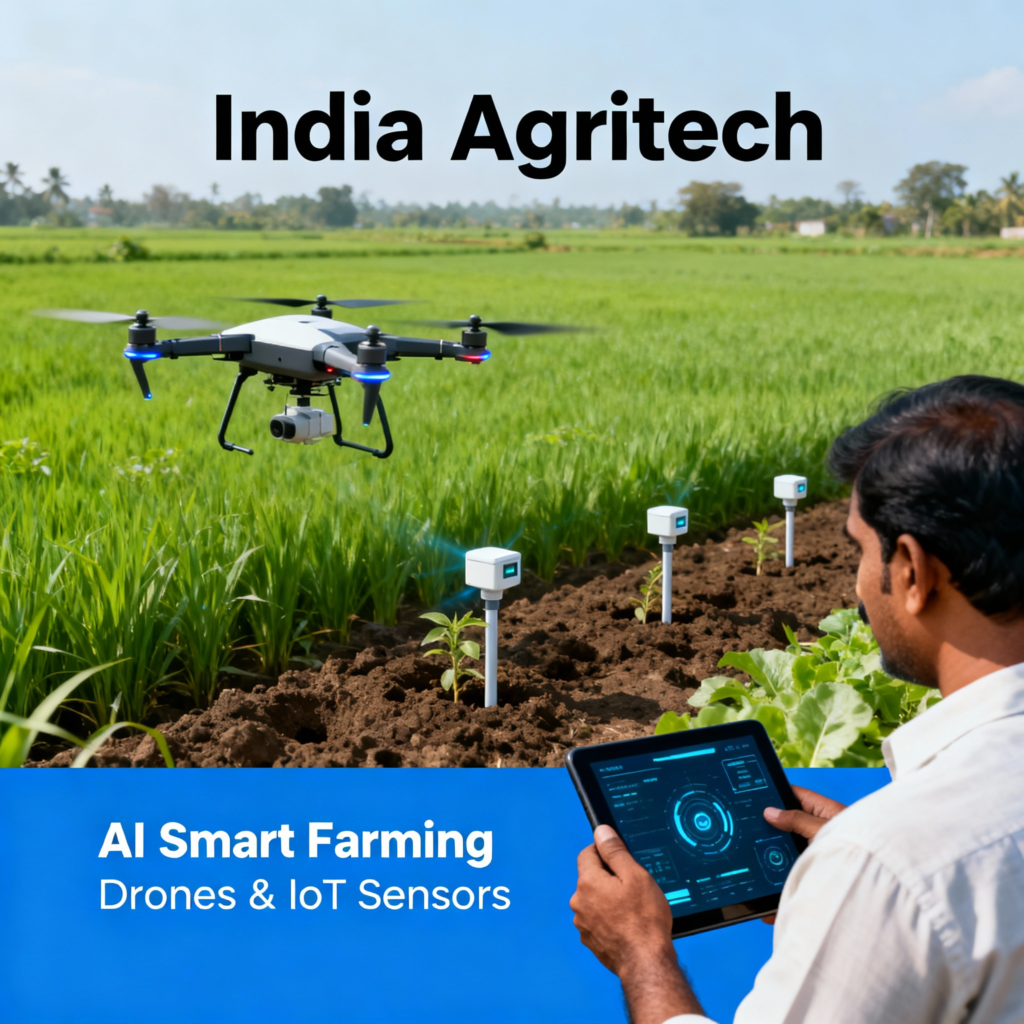
Key Highlights:
- India’s smart farming market surged to ₹6,458 crore ($785.4 million) in 2024 and is projected to reach ₹44,935 crore ($5.46 billion) by 2034 at 21.4% CAGR, driven by 5G connectivity and precision agriculture adoption
- Digital Agriculture Mission 2021-25 targets creating digital IDs for 11 crore farmers through AgriStack platform with ₹6,000 crore Smart Precision Horticulture Programme covering 15,000 acres and 60,000 farmers
- AI in agriculture market expected to grow from $1.7 billion in 2023 to $4.7 billion by 2028 at 23.1% CAGR, with precision farming adoption increasing yields up to 30% through drone monitoring and IoT sensors
- Punjab achieved 25% yield increase with significant water savings using IoT sensors, while Maharashtra’s Farm Vibes project delivered 40% crop yield improvement through AI-driven solutions
- Rural digital divide remains critical challenge with over 80% farmers operating less than 2 hectares requiring affordable technology access and digital literacy training for inclusive smart farming adoption
The Digital Transformation of Indian Agriculture
India stands at the cusp of an agricultural revolution powered by Artificial Intelligence and advanced electronics, transforming traditional farming practices into data-driven precision agriculture. With agriculture employing over 42.3% of India’s workforce and contributing 18.2% to GDP, the technological modernization of farming has become critical for productivity enhancement, sustainability, and farmer income doubling. ijsrem
The transformation is already underway: India’s smart farming market reached ₹6,458 crore ($785.4 million) in 2024 and is projected to surge to ₹44,935 crore ($5.46 billion) by 2034 at a remarkable 21.4% compound annual growth rate. This growth is powered by cutting-edge technologies including AI-powered crop monitoring, IoT-based precision irrigation, drone-assisted field surveillance, and blockchain-enabled supply chain transparency.
The stakes are enormous: with India’s population expected to reach 1.5 billion by 2030 and only 4% of Earth’s land cultivated for agriculture, the need for technological intervention to enhance productivity while conserving resources has never been more urgent. The global AI in agriculture market growing from $1.7 billion in 2023 to $4.7 billion by 2028 reflects worldwide recognition that traditional farming methods alone cannot meet future food security challenges. farmnout
Current State of Agritech in India: Market Dynamics and Growth Projections
Market Size and Investment Landscape
India’s agritech sector has witnessed exponential growth driven by government initiatives, private sector innovation, and farmer adoption of digital solutions:
Market Valuation Trajectory:
- 2024: ₹6,458 crore ($785.4 million)
- 2025 Projection: Over ₹8,000 crore ($1 billion)
- 2034 Target: ₹44,935 crore ($5.46 billion)
- Growth Rate: 21.4% CAGR sustained over the decade expertmarketresearch
Technology Segment Analysis:
AI and Machine Learning: ₹1,401 crore ($170 million) market size in 2023, growing to ₹3,870 crore ($470 million) by 2028 at 23.1% CAGR.
IoT and Sensors: Projected to reach ₹2,050 crore ($250 million) by 2025, enabling real-time soil monitoring, weather data collection, and automated irrigation control.
Agricultural Drones: Expected to exceed ₹494 crore ($60 million) by 2025, with applications in crop surveillance, precision spraying, and yield estimation.
Technological Intervention Categories
- Multi-spectral imaging satellites for crop health assessment
- Ground-based IoT sensors measuring soil moisture, pH, and nutrient levels
- Weather monitoring stations providing hyperlocal climate data
- GPS-guided machinery for variable rate application of inputs
Smart Irrigation Systems:
- Drip irrigation with IoT automation reducing water consumption by up to 40%
- Soil moisture-based trigger systems preventing over-watering and under-watering
- Weather-integrated irrigation scheduling optimizing water use efficiency
AI-Powered Analytics Platforms:
- Crop disease identification through image recognition algorithms
- Yield prediction models using historical and real-time data
- Market price forecasting for optimal harvest timing
- Supply chain optimization reducing post-harvest losses
Government Policy Framework: Digital Agriculture Mission 2021-25
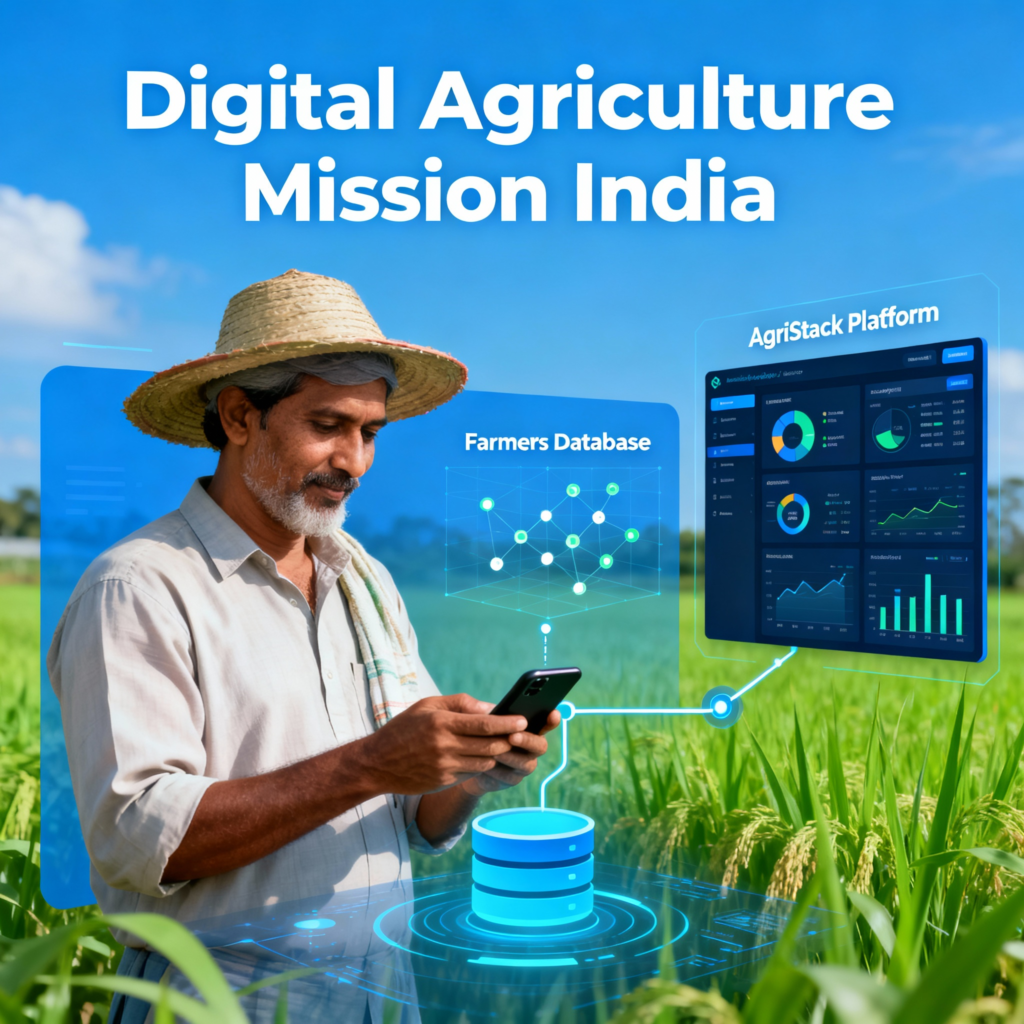
AgriStack: The Digital Foundation
The centerpiece of India’s agricultural digitization is AgriStack, a farmer-centric digital public infrastructure creating unified databases and service delivery platforms:
Three Core Components:
Farmers’ Registry: Digital identity system (‘Farmer ID’) similar to Aadhaar, linking farmers to land records, livestock ownership, crop data, demographic information, and government scheme benefits.
Geo-referenced Village Maps: Precise digital mapping connecting geographical information with physical land records, enabling accurate land management and agricultural planning.
Crop Sown Registry: Real-time crop data collection through mobile-based Digital Crop Surveys conducted each season, providing accurate agricultural statistics.
Implementation Progress and Targets
Pilot Project Results: Six states – Uttar Pradesh (Farrukhabad), Gujarat (Gandhinagar), Maharashtra (Beed), Haryana (Yamuna Nagar), Punjab (Fatehgarh Sahib), and Tamil Nadu (Virudhunagar) – have successfully tested AgriStack components.
Scaling Roadmap:
- FY 2024-25: 6 crore farmers receive digital IDs and 400 districts covered by Digital Crop Survey
- FY 2025-26: 3 crore additional farmers and nationwide district coverage
- FY 2026-27: Final 2 crore farmers completing 11 crore total target pib.gov
State Partnership Framework: 19 states have signed MoUs with the Ministry of Agriculture for AgriStack implementation, with ₹5,000 crore allocated for state incentives under the Special Assistance Scheme.
Supporting Digital Infrastructure Programs
India Digital Ecosystem of Agriculture (IDEA): Federated architecture integrating state and central databases for seamless information sharing and service delivery.
National e-Governance Plan in Agriculture (NeGP-A): Funding framework supporting AI, machine learning, robotics, and data analytics projects across agricultural value chains.
NITI Aayog-IBM Partnership: Strategic collaboration developing AI-driven crop yield prediction models and climate-smart agricultural advisory systems.
Key Applications of AI and Electronics in Indian Agriculture
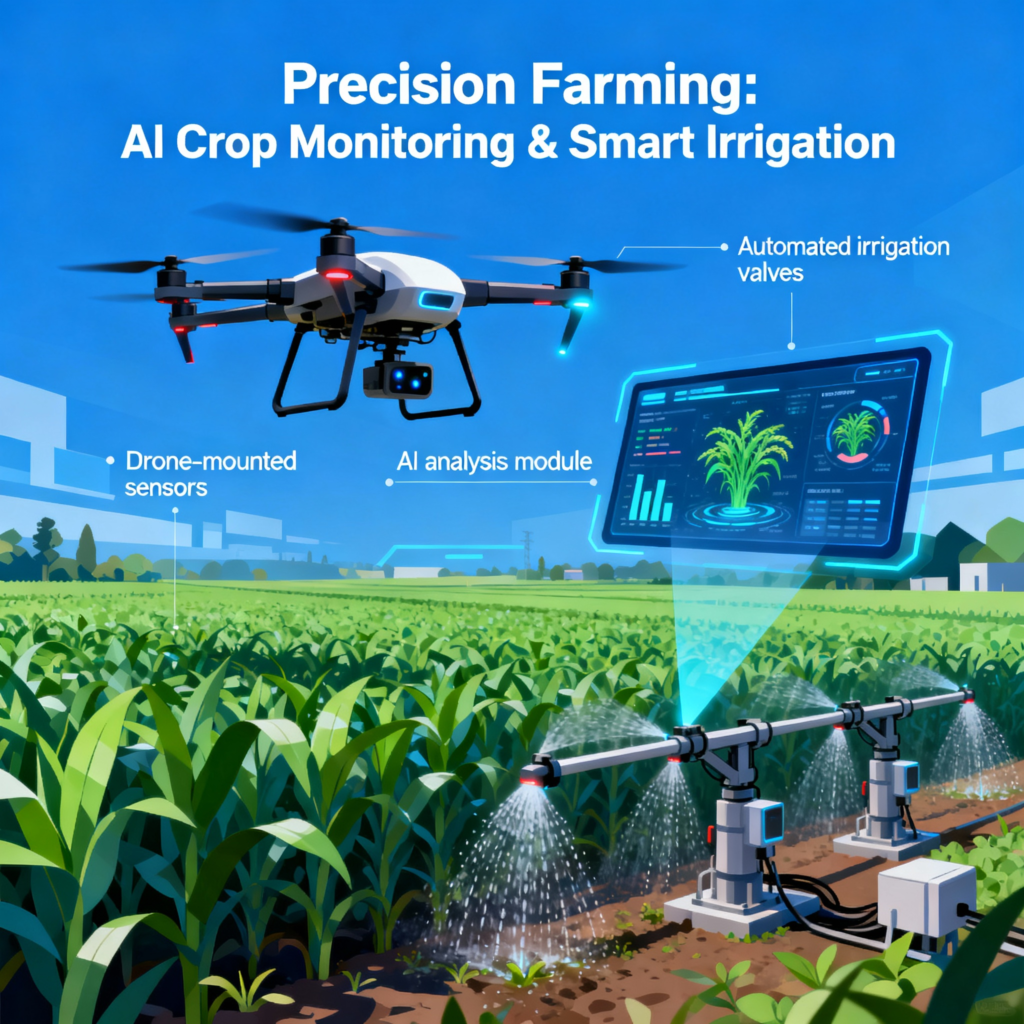
Smart Irrigation and Water Management
India’s “Per Drop More Crop” scheme has been revolutionized through AI and IoT integration:
IoT-Based Automation Systems:
- Soil moisture sensors automatically triggering irrigation systems when moisture levels drop below optimal thresholds
- Weather integration adjusting irrigation schedules based on rainfall predictions and evapotranspiration rates
- Remote monitoring capabilities allowing farmers to control irrigation from smartphone applications
Results and Impact: Punjab state achieved 25% yield increase with significant water savings using IoT sensor networks across demonstrative agricultural plots.
Precision Farming with Drones and Satellites
Aerial monitoring and intervention have transformed crop management practices:
Crop Health Monitoring: Multi-spectral drone imaging identifies plant stress, nutrient deficiencies, and disease outbreaks with 95% accuracy, enabling early intervention strategies.
Precision Spraying: AI-algorithm-guided drones perform targeted application of fertilizers, pesticides, and herbicides, reducing chemical usage by 20-30% while improving effectiveness.
Yield Estimation: Satellite and drone data integration provides accurate harvest predictions, helping farmers plan logistics and negotiate better market prices.
Pest and Disease Management Revolution
AI-powered diagnostic systems are transforming plant health management:
National Pest Surveillance System: Nationwide monitoring network using AI image recognition to identify and track pest outbreaks, enabling coordinated response strategies.
Mobile Applications: Apps like Plantix use smartphone cameras and machine learning algorithms to diagnose crop diseases with over 90% accuracy, providing instant treatment recommendations.
Predictive Analytics: Climate data integration with pest lifecycle models enables proactive pest management, reducing crop losses by up to 15%.
Weather Forecasting and Climate-Smart Agriculture
Predictive analytics platforms help farmers adapt to climate variability:
Hyperlocal Weather Predictions: AI models analyze multiple data sources to provide farm-specific weather forecasts with higher accuracy than traditional methods.
Climate Risk Assessment: Historical climate data combined with current patterns helps farmers select appropriate crop varieties and adjust planting schedules.
Early Warning Systems: Automated alerts for extreme weather events enable protective measures and loss mitigation strategies.
Market Intelligence and Supply Chain Optimization
AI-driven platforms are connecting farmers directly to markets**:
Price Prediction Models: Machine learning algorithms analyze market trends, demand patterns, and supply chain data to forecast commodity prices, helping farmers time their sales optimally.
Direct Market Linkages: Digital platforms eliminate intermediaries, ensuring farmers receive better prices while reducing consumer costs.
Supply Chain Transparency: Blockchain integration provides end-to-end traceability, enabling premium pricing for quality produce.
Impact and Success Stories: Measurable Transformation
Productivity and Yield Improvements
Precision farming adoption is delivering substantial productivity gains across diverse agricultural contexts:
National Averages: Precision farming techniques can increase yields by up to 30% compared to traditional farming methods, with highest gains in water-stressed regions.
Resource Optimization: IoT-based precision agriculture achieves:
- 25-40% water savings through smart irrigation systems
- 20-30% reduction in fertilizer and pesticide use
- 15-20% decrease in operational costs
State-Level Success Stories
Maharashtra’s Project Farm Vibes: AI-driven agricultural solutions delivered 40% improvement in crop yields across participating farms, with significant reductions in input costs and environmental impact.
Punjab IoT Initiative: Comprehensive sensor deployment across demonstration plots resulted in 25% yield increase with substantial water conservation, providing replicable models for other states.
Economic Impact on Farmer Incomes
Technology adoption is enhancing farmer economic outcomes:
Income Enhancement: Data-driven decision-making enables optimal input utilization, improved crop quality, and better market timing, contributing to income increases of 15-25%.
Cost Reduction: Precision application of inputs and automated monitoring reduce operational expenses by 10-20%, improving profit margins.
Risk Mitigation: Early warning systems and predictive analytics help farmers avoid losses from weather events and pest outbreaks.
Challenges and Barriers
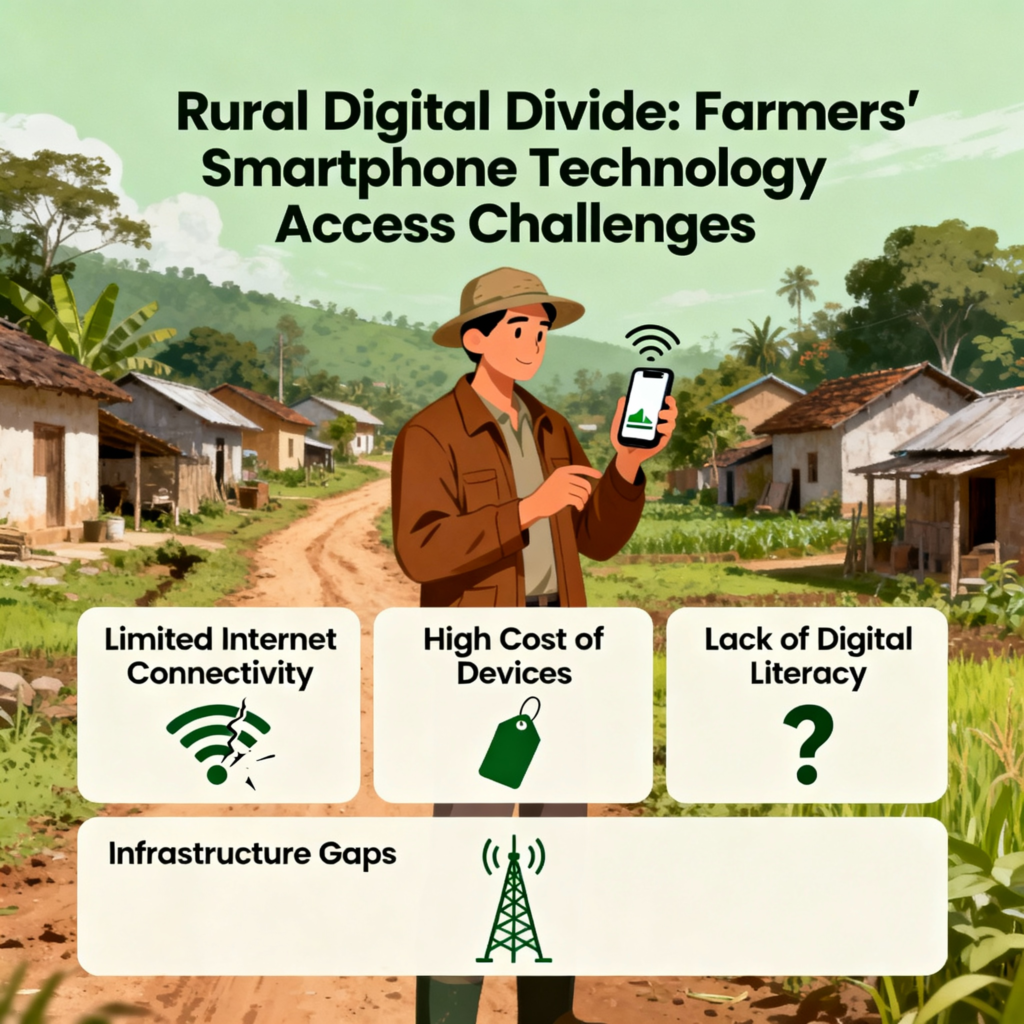
Digital Divide and Infrastructure Gaps
Rural connectivity remains the primary barrier to widespread agritech adoption:
Connectivity Statistics: Only 34% of rural India has reliable internet access, with significant variations across states and regions. 5G coverage remains limited to urban areas, despite its critical importance for real-time IoT applications.
Infrastructure Requirements: Smart farming technologies require:
- Consistent high-speed internet for data transmission
- Reliable electricity supply for sensor networks and automated systems
- Technical support infrastructure for maintenance and troubleshooting
Investment Barriers: High initial costs of smart farming equipment remain prohibitive for small and marginal farmers who constitute over 80% of India’s agricultural workforce.
Digital Literacy and Skill Gaps
Technology adoption faces significant human resource challenges:
Educational Barriers: Limited digital literacy among older farmers and language barriers in technology interfaces slow adoption rates.
Training Infrastructure: Inadequate extension services equipped to train farmers in digital agriculture technologies create implementation bottlenecks.
Generational Divide: Younger farmers show higher adoption rates, but land ownership often rests with older family members who are hesitant to embrace technology.
Fragmented Land Holdings and Scale Challenges
India’s land ownership patterns create unique challenges for precision agriculture implementation:
Plot Size Constraints: Over 80% of farmers operate plots smaller than 2 hectares, making large-scale precision farming equipment economically unviable.
Coordination Requirements: Effective pest management and climate adaptation strategies require community-wide coordination, which is challenging with fragmented ownership.
Technology Adaptation: Need for smaller, affordable technology solutions adapted to smallholder farming contexts.
Data Privacy and Cybersecurity Concerns
Digitalization raises critical governance questions about data ownership and security:
Data Sovereignty: Foreign technology providers collecting detailed farm data raise concerns about national food security information and farmer privacy.
Cybersecurity Vulnerabilities: Connected farm equipment and IoT networks create potential attack vectors requiring robust security frameworks.
Regulatory Frameworks: Absence of comprehensive data protection laws specific to agricultural data creates legal uncertainties for farmers and technology providers.
State-Level Innovations and Regional Models
Rajasthan: Digital Platform Leadership
Rajasthan has emerged as a pioneer in state-level agritech innovation:
Raj Kisan Sathi Portal: Comprehensive digital platform providing integrated agricultural services including weather forecasts, market prices, expert advisory, and government scheme information.
Agri-Tech Start-up Policy 2019: Supportive regulatory framework encouraging private sector innovation through incubation support, funding assistance, and regulatory sandboxes.
Tech-Driven Irrigation Projects: Solar-powered water pumping systems integrated with smart irrigation controllers enabling efficient water management in arid regions.
Gujarat: Solar and Sustainability Integration
Gujarat’s model combines renewable energy with precision agriculture:
Solar-Powered Irrigation: Grid-connected solar pumps with net metering allow farmers to generate income from excess solar power while ensuring irrigation security.
Crop Diversification: Climate-smart agricultural practices supported by technology enable farmers to shift from water-intensive crops to drought-resistant varieties.
Cooperative Integration: Technology deployment through existing cooperative structures ensures wider reach and cost-effective implementation.
Uttar Pradesh: Innovation Hub Development
UP is establishing comprehensive agritech ecosystems:
ANNAM.AI-IIT Ropar Partnership: Collaboration between AI startups and academic institutions developing localized agricultural AI solutions.
SVPUAT Meerut Agritech Innovation Hub: University-based research center focusing on practical technology applications for UP’s diverse agricultural contexts.
Farmer Producer Organization (FPO) Integration: Technology deployment through FPOs ensuring collective bargaining power and shared infrastructure costs.
Socio-Economic Implications and Impact Assessment
Employment Generation and Entrepreneurship
Agritech expansion is creating new economic opportunities in rural areas:
Rural Tech Services: Growing demand for technical support, data analysis services, and equipment maintenance is creating local employment opportunities.
Agritech Entrepreneurship: Startups like CropIn, Fasal, DeHaat, and Stellapps are generating high-skilled employment while solving agricultural challenges.
Value Chain Integration: Technology-enabled direct market linkages and processing facilities create additional income sources for rural communities.
Food Security and Productivity Enhancement
Technological interventions directly contribute to national food security:
Yield Optimization: AI-driven precision agriculture can help India achieve food security for projected 1.5 billion population by maximizing productivity on existing agricultural land.
Climate Resilience: Technology-enabled adaptation strategies help farmers cope with increasing climate variability, ensuring stable food production.
Nutritional Quality: Precision nutrition management enables production of nutrient-dense crops, addressing India’s malnutrition challenges.
Environmental Sustainability
Smart farming practices contribute to environmental conservation:
Chemical Reduction: Precision application technologies reduce fertilizer and pesticide use by 20-30%, minimizing environmental contamination.
Water Conservation: Smart irrigation systems achieve 25-40% water savings, crucial for water-stressed regions.
Soil Health Management: Continuous monitoring and data-driven soil management prevent degradation and enhance long-term productivity.
Policy Recommendations for Inclusive Agritech Development
Infrastructure Development Priorities
Comprehensive digital infrastructure is essential for agritech success:
Rural Connectivity Enhancement: Accelerated 5G rollout in rural areas with affordable data plans tailored for agricultural applications.
Power Infrastructure: Reliable electricity supply through solar microgrids and grid modernization supporting 24/7 connectivity for IoT systems.
Technical Support Networks: Establishment of district-level technology service centers providing equipment maintenance, training, and troubleshooting support.
Farmer-Centric Technology Design
Technology solutions must be adapted to smallholder contexts:
Affordable Solutions: Government support for cost-effective technology development targeting small and marginal farmers.
Collaborative Models: Shared infrastructure through Farmer Producer Organizations and cooperative societies reducing individual investment burdens.
Vernacular Interfaces: Technology platforms in local languages with intuitive user interfaces suitable for farmers with limited formal education.
Public-Private Partnership Frameworks
Effective collaboration between government and private sector is crucial:
Innovation Incentives: Policy support for agritech startups through tax incentives, regulatory sandboxes, and funding assistance.
Risk Sharing Mechanisms: Government-backed insurance schemes protecting farmers from technology-related losses during adoption phases.
Data Governance: Clear frameworks for data ownership, privacy protection, and ethical use ensuring farmer interests are prioritized.
Capacity Building and Education
Comprehensive human resource development supports sustainable adoption:
Extension Service Modernization: Training agricultural extension workers in digital technologies and data interpretation.
Farmer Education Programs: Regular training sessions on technology use, data analysis, and digital marketing through existing rural institutions.
Youth Engagement: Specific programs encouraging young farmers to adopt and champion advanced agricultural technologies.
Future Outlook: Transforming Indian Agriculture by 2030
Technology Integration Trends
Emerging technologies will further revolutionize agricultural practices:
5G and Edge Computing: Real-time processing of large datasets from IoT sensors enabling instant decision-making and autonomous systems.
Artificial Intelligence Evolution: Advanced machine learning models providing more accurate predictions and personalized recommendations for individual farms.
Blockchain Integration: End-to-end traceability systems ensuring food safety, quality certification, and premium market access.
Market Expansion Projections
Agritech sector growth will create substantial economic opportunities:
Market Size: Indian smart farming market expected to reach ₹44,935 crore ($5.46 billion) by 2034, making it one of the world’s largest agritech markets.
Employment Generation: Projected creation of 5 million new jobs in agritech services, data analysis, and rural technology support by 2030.
Export Opportunities: Technology-enabled quality assurance and traceability will enhance India’s agricultural export competitiveness.
Policy Evolution Requirements
Governance frameworks must evolve to support technological transformation:
Regulatory Modernization: Updated agricultural policies incorporating digital agriculture principles and technology governance frameworks.
International Cooperation: Technology transfer partnerships and knowledge sharing agreements with leading agricultural innovation countries.
Research and Development: Increased investment in agricultural research institutions focusing on technology development and adaptation.
Conclusion: Harvesting the Digital Future of Indian Agriculture
India’s agricultural transformation through AI and electronics represents one of the most significant policy initiatives in the country’s development trajectory. With the smart farming market surging to ₹44,935 crore by 2034 and AI agriculture applications growing at 23.1% CAGR, the technological revolution is already reshaping rural landscapes and farmer livelihoods.
The Digital Agriculture Mission 2021-25’s ambitious target of digitizing 11 crore farmers through AgriStack platform demonstrates unprecedented government commitment to agricultural modernization. Success stories from Punjab’s 25% yield increases and Maharashtra’s 40% productivity improvements provide concrete evidence that technology-driven farming can deliver transformational results.
However, challenges remain formidable: the rural digital divide, fragmented land holdings, and limited digital literacy require comprehensive policy interventions that balance technological advancement with inclusive development. Over 80% of farmers operating less than 2 hectares need affordable, scalable solutions rather than high-end precision farming equipment designed for large commercial operations.
For UPSC aspirants and governance professionals, this transformation illustrates critical intersections between technology policy, rural development, and sustainable agriculture. Understanding how AI, IoT, and blockchain technologies can address food security challenges while empowering smallholder farmers becomes essential for evidence-based policymaking in the 21st century.
The path forward requires balanced approaches: combining technological innovation with farmer-centric design, ensuring digital inclusion while promoting efficiency, and leveraging private sector capabilities while protecting public interests. State innovations from Rajasthan’s digital platforms to Gujarat’s solar irrigation models demonstrate that locally-adapted solutions can scale successfully across diverse agro-climatic zones.
Success in India’s agritech revolution will determine whether technology becomes a tool for inclusive rural development or exacerbates existing inequalities. The choices made today in policy design, infrastructure investment, and farmer education will shape agricultural productivity, environmental sustainability, and rural prosperity for generations.
The stakes extend beyond agriculture: feeding 1.5 billion people sustainably while adapting to climate change and conserving natural resources represents one of humanity’s greatest challenges. India’s agritech experiment offers lessons for the global community on harnessing technology for sustainable development.
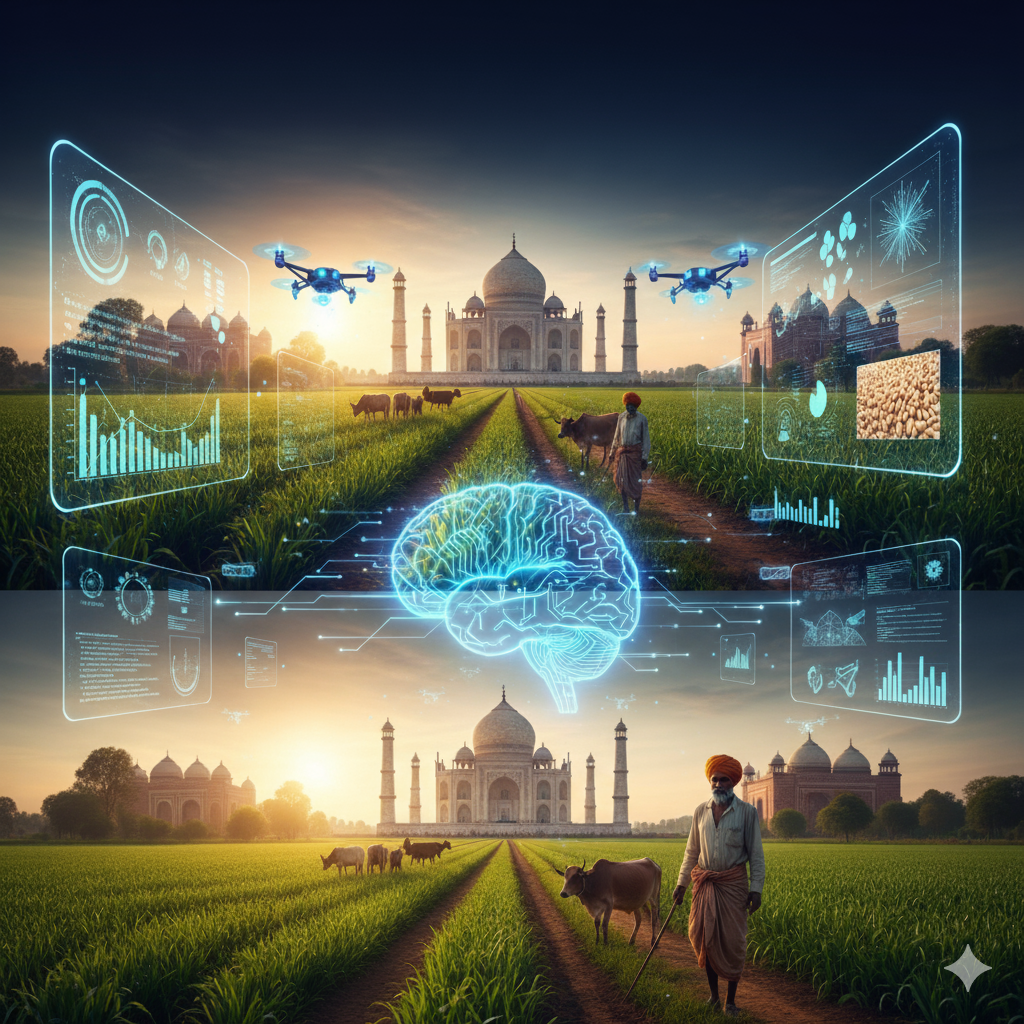





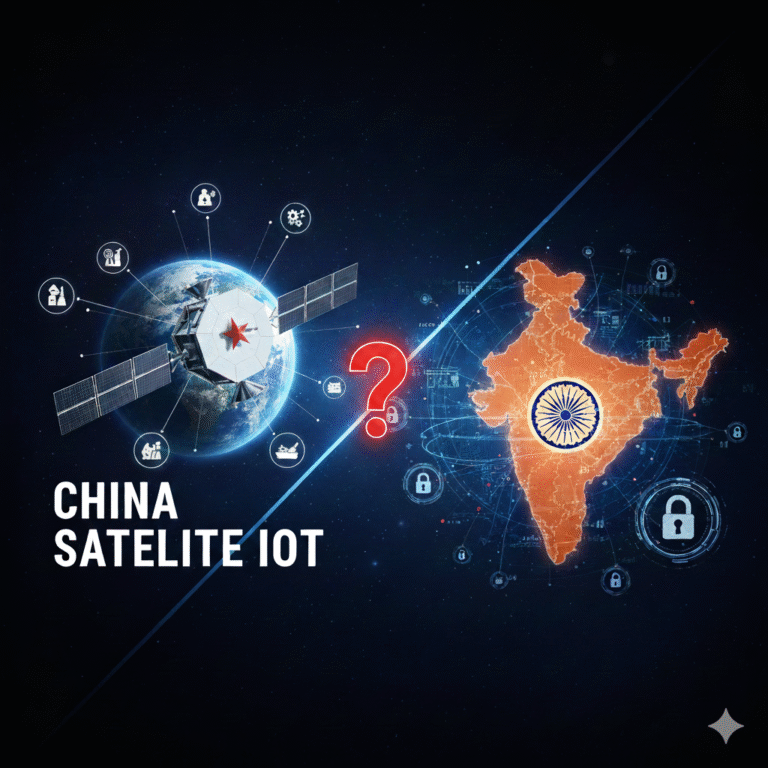
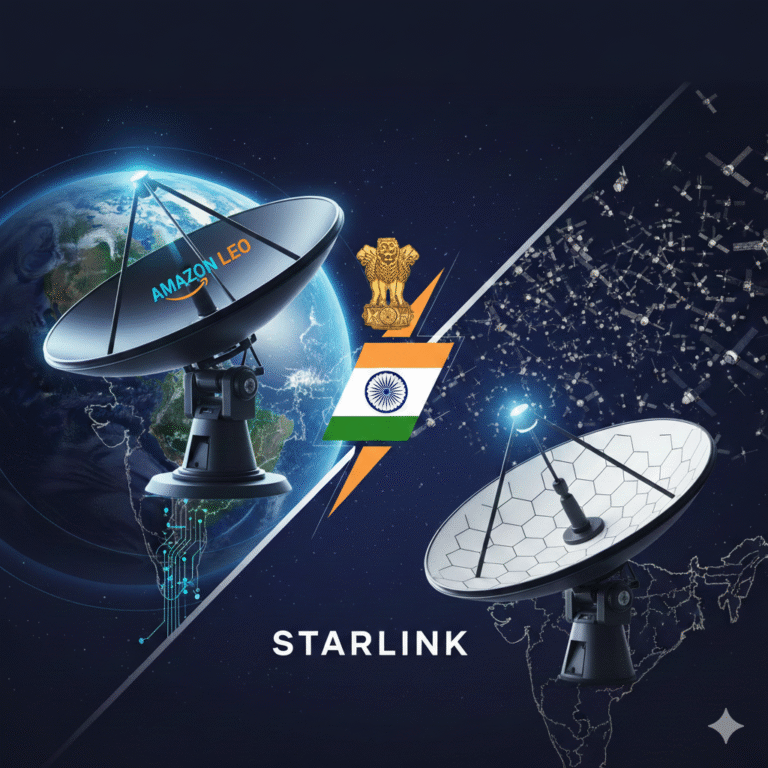

+ There are no comments
Add yours